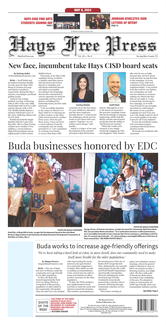This Week in Texas History
by BARTEE HAILE
Howard Hughes obsessively tinkered with the “Silver Bullet” on Sept. 7, 1935 in secret preparation for the plane’s Friday the 13th maiden flight.
It was love at first flight for the lanky Texan, who took his first airplane ride at 14 with his father. Upon assuming complete control four years later of the family business, a Houston-based tool company, the restless orphan could afford his two favorite pastimes – movie making and aviation.
In 1927 Hughes began filmi ng “Hell’s Angels,” a $3.8 million epic about aerial combat in The Great War, which he wrote, directed and bankrolled. To add authenticity to the death-defying dogfights, he bought 87 vintage aircraft and wound up the proud owner of the largest private air force in the world.
While working day and night on “Hell’s Angels,” the movie mogul found time for flying lessons. The ink had hardly dried on his pilot’s license, when he cracked up his first plane. The amateur aviator walked away from the mishap with minor facial cuts, but he would not always be so lucky.
In September 1932, soon after founding Hughes Aircraft, the elusive tycoon pulled one of his patented vanishing acts. He hopped a train to Fort Worth and using the alias “Charles Howard” took a job as baggage handler/apprentice pilot with American Airlines. Before the impostor was recognized by an executive, who had seen him at the New York premiere of “Hell’s Angels,” a supervisor reported “he has the makings of a first-rate airline pilot.”
Hughes, however, had a far loftier ambition. Envious of the public adoration accorded Charles Lindbergh after his solo conquest of the Atlantic, the multimillionaire wanted to be the next “Lone Eagle.”
Returning to southern California following his Fort Worth masquerade, Hughes ordered his top-notch team of aeronautical engineers and mechanics to “build me the fastest airplane in the world.” Two years and $120,000 later, the H-1 or “Silver Bullet” rolled out of the top-secret hanger at the Glendale plant.
Hughes wasted no time in putting his investment to the test. In September 1935, he challenged the record of 314 miles per hour before a celebrity-studded crowd that included Amelia Earhart two years before her mysterious disappearance over the Pacific.
Seven times the “Silver Bullet” streaked past the tracking station posting an average speed of 352 mph. An eighth run was unnecessary, but Hughes’ ego would not let him call it a day. Coming out of a steep dive, he ran out of fuel and plowed into a beet field at 100 miles an hour. The costly craft sustained only a bent propeller, while the embarrassed barnstormer got off even lighter with a few bumps and bruises.
After that Hughes straightened up and flew right into the record book. For shaving two full hours off the transcontinental time, he was awarded the Harmon International Trophy as the greatest pilot on the planet in 1936. Two summers later, the relentless record-setter circled the globe in five hours in under four days and returned home to the frenzied fanfare he so desperately desired.
More a lone wolf than a lone eagle, the reclusive industrialist quickly tired of the limelight. With another war around the corner, he had better things to do than pose for photographers and comb ticker tape out of his hair.
Leaving actress Ava Gardner in a Las Vegas suite in May 1943, Hughes drove to Lake Mead for the 4,589th test landing of his new seaplane. He hurried through the preflight check and forgot to make sure the tail had been loaded with ballast. It had not.
The nose-heavy amphibian dipped into the lake at 80 mph. The impact tore loose a propeller, which ripped through the fuselage like a buzz saw, splitting the skull of an employee and knocking a government inspector into the water. Both died, and the dazed pilot nearly drowned as the shredded seaplane sank like a rock in less than a minute.
Anyone in his right mind, and many were beginning to believe Hughes was not, would have left future tests to the hired hands. But three years later he broke a promise to Lana Turner, who had a premonition of disaster, and squeezed his six-foot-plus frame into the cockpit of the XF-11.
Ignoring the military flight plan for the desert, Hughes put the spy plane through its paces over congested Los Angeles. When the controls froze, he tried to land the crippled aircraft on the Beverly Hills Golf Course but crashed into a residential neighborhood.
Pulled from the fiery wreckage by a brave bystander, Hughes had burns over 78 percent of his body plus a punctured lung, five dozen serious lacerations, ten broken ribs and a fractured nose, left knee and left elbow. The most optimistic prognosis gave him a fifty-fifty chance of survival.
Howard Hughes defied the doctors and walked out of the hospital a month later. But he paid a very high price for the miraculous recovery. Until his dying day in 1976, the high-flying Texan was hopelessly hooked on pain-killing drugs.
Bartee Haile welcomes your comments, questions and suggestions at haile@pdq.net or P.O. Box 152, Friendswood, TX 77549. And come on by www.twith.com for a visit!




